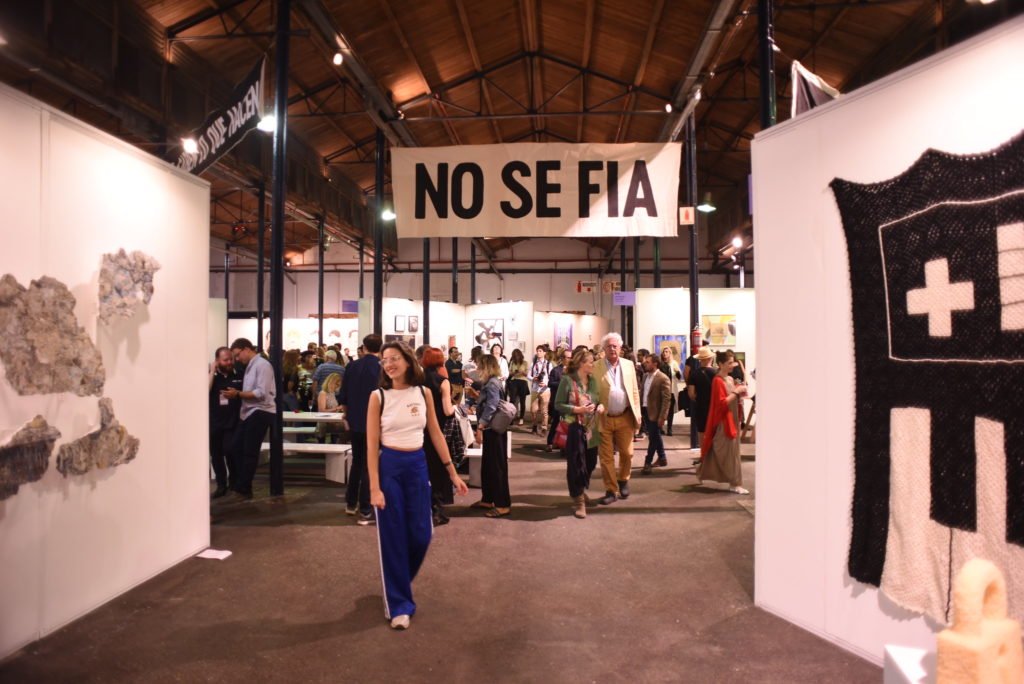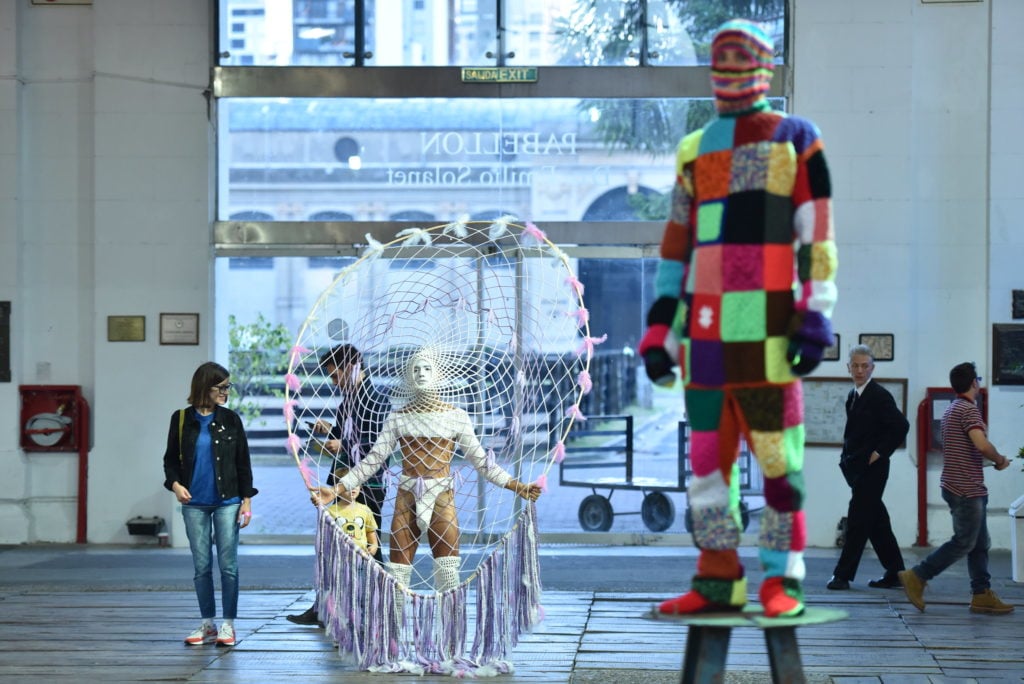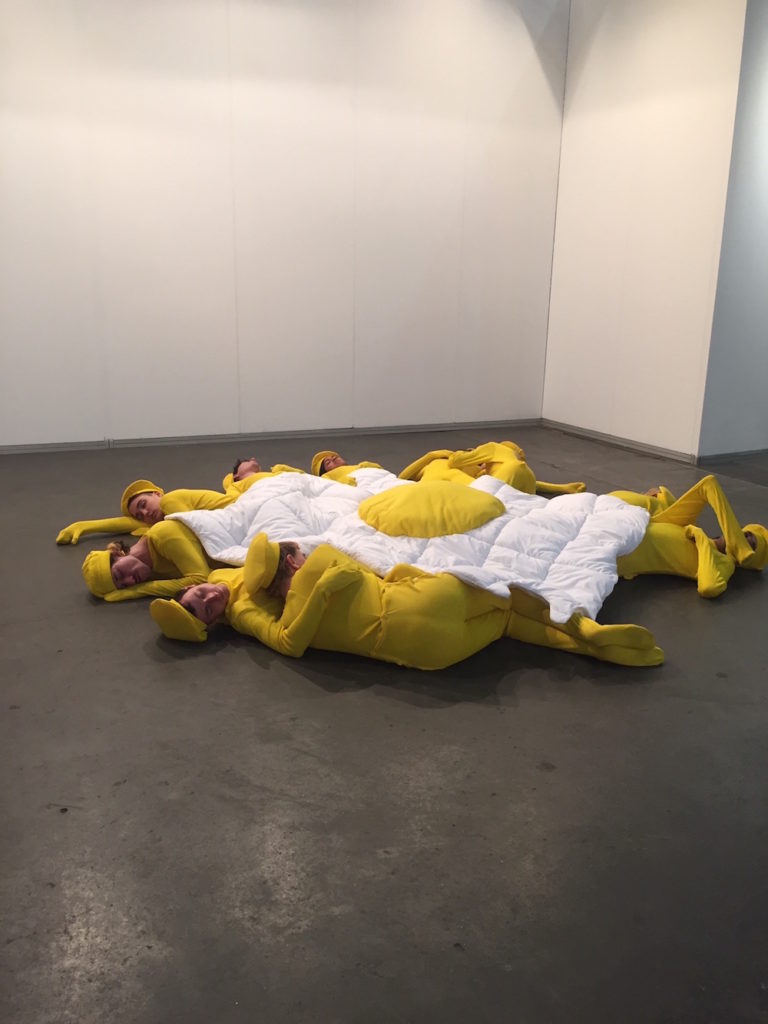Art Fairs
Amid a Struggling Economy, Few Dealers Are Reporting Sales at the arteBA Fair. Strangely, They Don’t Seem to Mind
Are visitors seeking refuge in art during tumultuous times?

Are visitors seeking refuge in art during tumultuous times?

Eileen Kinsella

Judging from the enthusiasm surrounding Buenos Aires’s current Semana del Arte (April 8–14) and the bustling attendance during the opening days of this year’s arteBA fair, one would never know that this same country is fighting to emerge from a currency crisis. Last year, the Argentinian economy shrank 2.5 percent and unemployment ticked up to nine percent.
Whether it’s due to the fact that experts are expecting economic reforms and recovery (economists say the country will return to growth during the second quarter of this year), or that the already thriving arts and culture scene of Buenos Aires has been further boosted since it became the first participant in the Art Basel Cities program, the mood at Wednesday’s crowded VIP opening preview was decidedly upbeat.
Whether or not sales will follow is another question. In the first few days, almost no galleries reported sales to artnet News, and the few that did sold smaller items priced under $5,000. Oddly, however, nobody seemed particularly bothered by this.
“arteBA has a long experience in crisis like that we’re going through now,” says the fair’s Tomas Powell. The year “2001 was especially terrible and that was an exceptional fair, maybe the best in a long time. I’m not saying that’s definitely going to happen again, but it seems like there is something in the Argentine mentality that seeks refuge in art in difficult times.”
Some dealers even worked to present projects far outside the reliable chocolate-box approach—a move one is more accustomed to seeing during flush times. Local gallery UV Studios mounted a buzzed-about performance piece, Me huevo loca by Lolo y Lauti, in which performers dressed in yellow costumes and hats, draped in a “fried egg” blanket, lay on the floor for hours at a time, occasionally shifting restlessly and mimicking the subtle movement of food on a grill.

arteBA 2019. Courtesy arteBA Fundación.
With the exception of a handful of galleries from Paris, several from Spain, and one each from Brussels, Italy, and Germany, the fair was focused exclusively on Latin America. There were more than 40 galleries from Buenos Aires, as well as a selection from Brazil, Mexico, Peru, and Chile—though some noted a dip in representation of some Latin American countries due to Argentina’s economic crisis.
Fair organizers rolled out a fresh layout and introduced new sections including Cardinal, which pairs galleries from different regions in shared booths, and Utopia, a section for young galleries showing Latin American contemporary art housed in a separate pavilion. That section delivered some of the raw, scrappy energy familiar to visitors of younger fairs like Spring Break and NADA.
After making a splash this past September with a citywide public art event curated by High Line art curator Cecilia Alemani, Art Basel Cities’s planning around the fair was more low key. The organizers held a series of “master classes” and other talks featuring more than 30 speakers held in structures in the sprawling park of La Rural.
There is no direct agreement between Art Basel and arteBA, according to Powell. (Art Basel Cities has entered into an agreement with the foundation behind the fair, rather than the fair itself, for the talks, which are technically a separate event.) But it’s undeniable that the cities initiative has helped raise the visibility of Argentine art. Two Argentine galleries accepted to the most recent edition of Art Basel Miami Beach, Walden and Isla Flotante, say they did quite well there on the back of renewed buzz.
And artist Gabriel Chaile, who participated in last September’s public art show by bringing an oven to one of the city’s poorest neighborhoods, will bring his interest in food and community to Art Basel, where he plans to cook at Barro gallery’s booth with cookware he exchanged with local Swiss restaurants.

Loto Lauti, Mi huevo loca, a performance at arteBA presented by UV Studios, Buenos Aires. Photo by Eileen Kinsella
But not everyone, it seems, understands the finer points of the Art Basel Cities arrangement. Several dealers we asked about the program and its impact on the fair shrugged; a few thought the initiative was geared more towards the city’s institutions than the market.
Violeta Mansilla of UV Studios says she had not seen evidence that Art Basel Cities had shaped the reception of this year’s fair. The strong group of VIPs that Art Basel delivered for its September program did not appear to return in equal force, she notes. “I think the only positive impact is that the city government organized the ‘art week’ and that helped the press and communication,” she says.
Art Basel reinforces that it is playing a long game. “On both sides of the partnership we are extremely happy on what has been achieved so far,” Patrick Foret, Art Basel’s director of business initiatives, tells artnet News. “We see this as an ongoing relationship—and we are certain that it will have a long term legacy and resonance. The relationships and connections created in the past two years will only keep developing.”
Some visiting galleries also feel that their relationship to the region remains worth investing in. Shirley Morales, owner of Los Angeles-based ltd los angeles, returned to arteBA for the second consecutive year after being invited to the new Cardinal section, where she shared a booth with Buenos Aires veteran Nora Fisch.
Morales told artnet News she felt it was important to return to “deepen” relationships with the collectors she met last year. By the end of the first day, she had placed two works by Felix Beaudry, a young and very recent graduate of RISD, with a Brazilian collector and a New York collector. Asking prices averaged about $2,000 each.
Larger sales remain elusive, but “from my conversations here on the ground with various key players from the local art scene in Buenos Aires, the mood here is very much upbeat and optimistic,” Foret says.